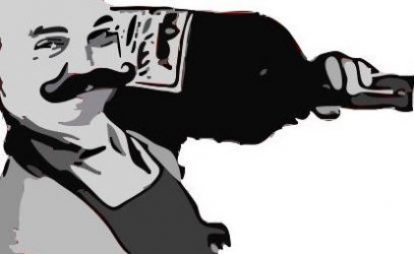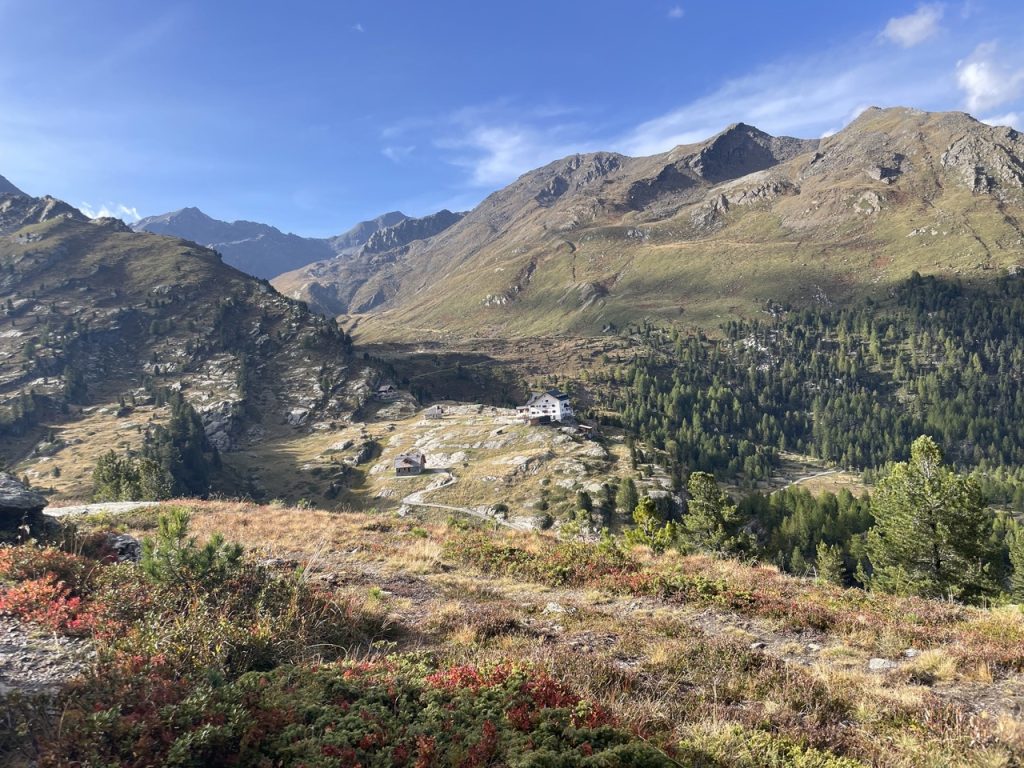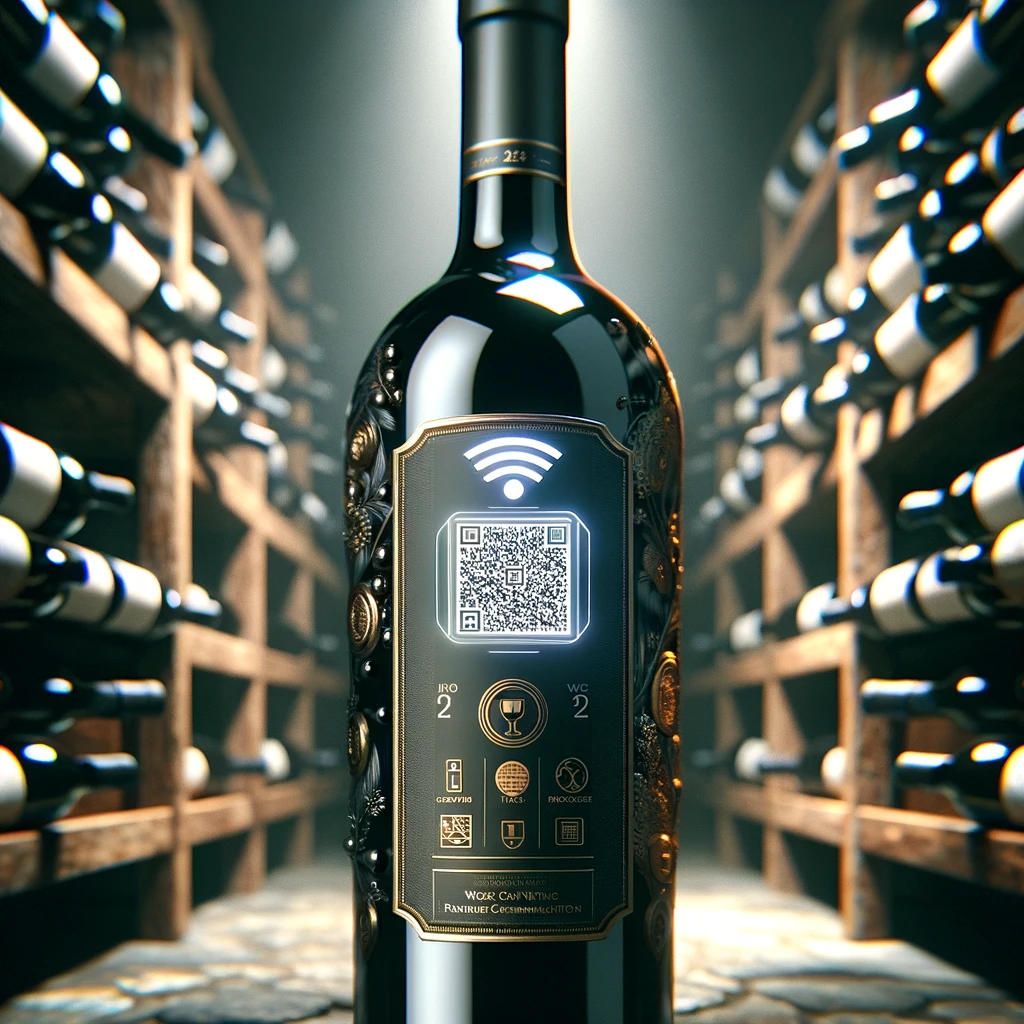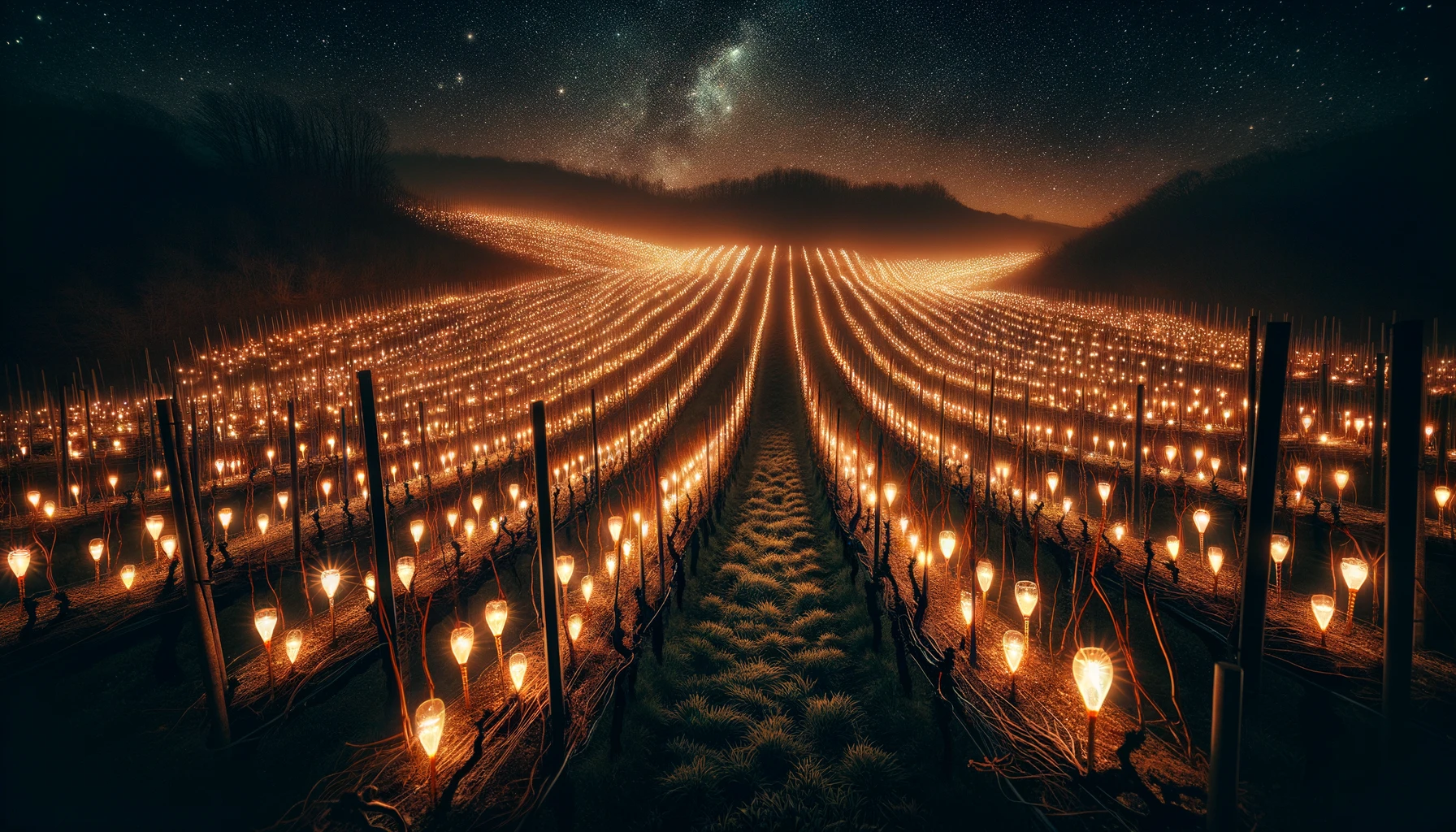Small but nice. Very nice indeed. That could be a summary of the wines of the Italian alpine province of Südtirol. It wouldn’t do it justice though. Small it may be but not only are its wines of remarkable quality, it also boasts of enormous diversity in varieties, climates and soils. Time to take its pulse.
Tales from a Wine Gem in the Alps
Prologue
Südtirol? Where?
You haven’t heard of Südtirol and got no clue where it is? Well, that’s not unheard of. The heading though might have given it away: it’s in the Alps, or to be more precise in the northeast of Italy, bordering Austria and Switzerland, surrounded by the spectacular Dolomite Mountains, a UNESCO World Heritage Site.
It also comes with an interesting history as it was part of the Austro-Hungarian Empire until it was annexed by Italy following the First World War. As a result, today German and Italian are both official languages, while in some parts Ladin is the third official language. The result could hence be a slight confusion regarding its name: Südtirol in German and Ladin, Alto Adige in Italian or South Tyrol in English – take your pick.
Spoiled for choice
However, not only in culture and language is it an interesting combination. The wine region of Südtirol is made of only approximately 5,700 hectares (or just above 14,000 acres), which in turn are cultivated by about 5,000 winegrowers. Do the math and you get to an average area of little more than one hectare per farmer. This area is spread out mostly on steep hills starting at 200 meters above sea level and goes up to its highest vineyards that sit above a thousand meters. 98% of the area under vine is used for DOC, with two thirds white to one third red wines. Talking about red wine, the autochthonous red grape Vernatsch or Schiava used to be the most cultivated but has recently been overtaken by Pinot Grigio as well as several other white varieties, which have been contributing to Südtirol’s international success story. Having said that, there are 20 grape varieties available for producing DOC wines plus some others making for an interesting selection, especially when considering the limited size of the region. Now add to the mix the different altitudes, changing micro climatic conditions depending on where you are and rather variable soil structures – I seem to recall to have read of about 150 different soil types somewhere, but quartz, slate, calcareous structures and, of course, dolomite, it’s all there – and you get the tool kit for seemingly endless combinations for producing quality wine of literally all sorts.
So much for the theory, but now for the practical part. Over the course of three events spread out over three weeks, I had the opportunity to check the wine region’s pulse. This is the story of what I experienced and discovered during these.
Stage One: Cortaccia Rossa
It is a somewhat strange sensation when on a warm, sunny day in late summer you walk into the Felsenkeller, that is the Rock Cellar of the winery of the Laimburg Research Centre. Built in the 1980s, thanks to the force of five tons of dynamite that created enough space for cellars with a naturally constant room temperature of about 14 °C plus a 300 m² hall that serves as a tasting room. This is an extraordinary location by itself. Yet, extraordinary might also be the right word for the efforts of a group of four producers from close by in the lower Adige valley that borders the Trentino province.
As a general description, Benjamin Lewin MW highlights in his introduction to the wines of Italy the diversity of climates – from cool climate Trentino-Alto Adige in the far north, to beating hot Sicily in the far south. Still, at the heights of summer, it can sometimes feel as if the map of Italy has been turned upside down in the most southern part of Alto Adige. The vineyards between 200 and 350 meters above sea level often experience what could be described as extreme heat during the day. This, planting the white varieties for the wines that the region is internationally renowned for does not sound like a good idea, but there is, of course, a solution for this problem, which is at the center of the first event I attended.
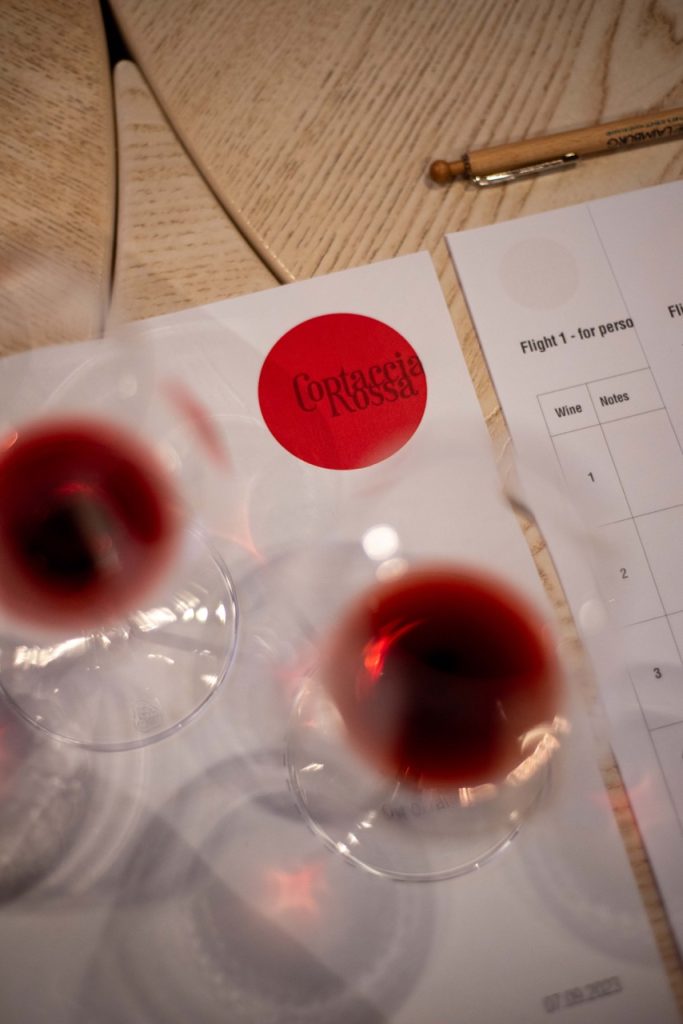
Cortaccia Rossa is the name of a bi-annual event, now in its fifth edition, that promotes the Bordeaux style wines made by the four producers with vineyards around the village of Kurtatsch or Cortaccia in Italian. They – that is Tiefenbrunner, Cantina Kurtatsch, Baron Widmann and Peter Dipoli – think to have found ideal conditions for growing varieties such as Merlot, Cabernet Sauvignon and Cabernet Franc. Whilst summer days are generally very warm in the area, the mostly east-facing vineyards sit below a mountain range that protects them from the hot afternoon sun and witnesses cooling fall winds in the evening. Add the significant drop in temperatures during the night and you get the conditions to keep freshness and acidity, which is expressed by “a bright, almost alpine seeming fruit in the nose”, according to the producers.
Combine this with the soil compositions – north of the village you have a high percentage of clay, which usually is a great fit for Merlot, while south of the village, you’ll find soils more suitable for Cabernet Sauvignon with gravel, sandier and significantly lighter ground – and you will understand why these producers “strongly believe in the potential of these vineyard sites and the distinctive style of their wines”.
To give evidence to their beliefs, they came up with the idea of Cortaccia Rossa and in 2015 pitted for first time their wines in a blind tasting against prestigious examples from Bordeaux. The fifth edition in 2023 followed the same basic rules and in four flights each producer had its latest vintage lined up (alongside an older vintage to give testament to the longevity of their wines) against two other competitors from other renowned producers from around the world. Each taster had to assign points on the usual 100-points scale to the local heroes as well as the counterparts from famous Bordeaux chateaux or other big hitters such as Opus One or Redigaffi.
It takes courage and confidence to compare yourself to such competition and this was rewarded with a result that could also be considered extraordinary: not so much because of the points that were awarded to each wine and that saw the South Tyrolians win their home game. You might argue that such a result has limited value, since all such tastings were subjective to some extent, that the circumstances could not be considered fair because of, say, the limitations due to varying evolution of the different styles, or that the participants were particularly favorable towards the wines of Alto Adige and their style. What matters is that even if you were of this opinion and therefore inclined to disregard the numbers – and I can agree somewhat that ratings for wines never are an exact science – you could not disregard the fact that these wines not only held their ground but did very well. In the end, the thing that matters – and that might not be my personal opinion only – is that these red wines from Südtirol are serious contenders among the cream of the crop. And that already is one hell of a statement, I suppose.

Stage Two: Alto Adige Wine Summit
The following day saw a test of a different kind, one that I had set myself and accepted gladly: having been invited to the grand tasting of the Alto Adige Wine Summit, I had the opportunity to sample the latest vintages from almost three hundred wines from approximately one hundred local producers and I was determined to make the most of it.
The overall themes were already evidential and some of them are not limited to Südtirol such as the effects of climate change, which is particularly worrisome when you are known to produce fresh white wines; on the other hand, it has helped with ripeness of the reds – see above. Climate change isn’t only about increased temperatures as Alto Adige has had to learn just as many other wine producing regions; extreme weather events like draught, late frosts or hail have caused more immediate damage to the crops here just as elsewhere during the past years than just the increased average temperatures might indicate.
A remedy of sorts comes in the shape and impact of altitude as vineyards range between 200 and 1,100 meters above sea level; yet, one needs to understand that not all varieties are made for such heights as only a few manage to ripen properly in such circumstances.
Another theme is that sparkling wine is on a high here as elsewhere in Italy where many producers and regions fueled by the success of Prosecco and Franciacorta have taken to producing bubbles. While the share of sparkling wine , which is produced as Metodo Classico, comparatively is still fairly small, the number of labels has risen significantly over the past years.
And just as the choice of sparkling wines has risen, so has the number of independent wine producers. However, the cooperatives still reign supreme and the quality they produce keeps on defying the general assumption that such organizations usually produce lower quality than their competitors. But more on that below.
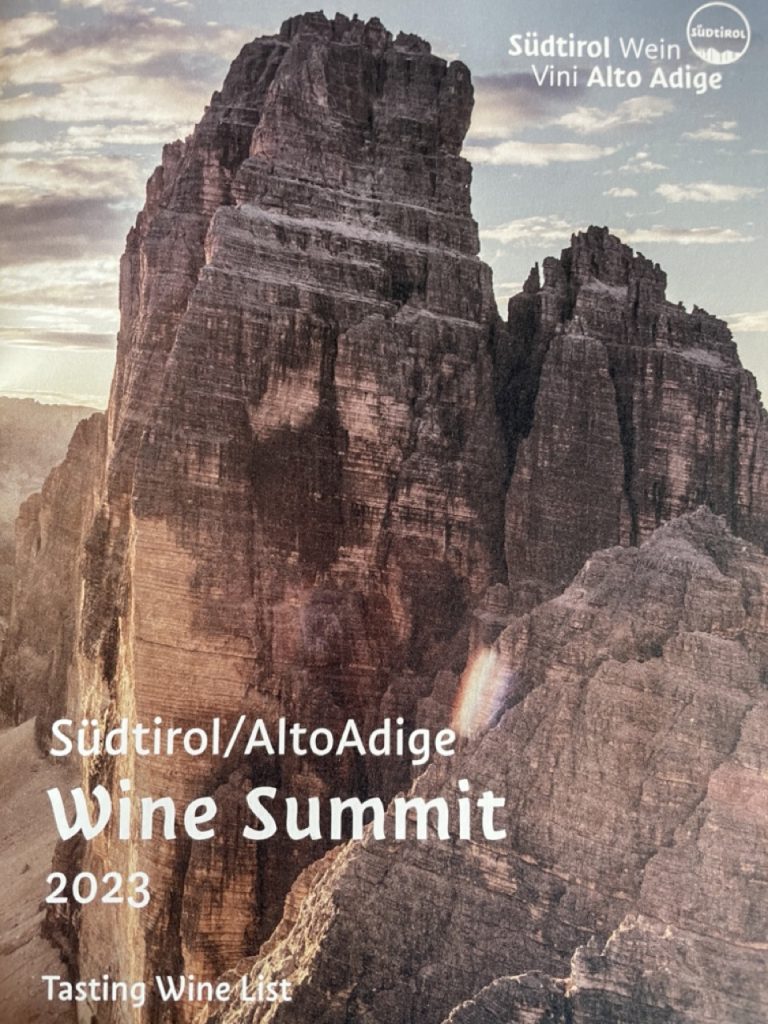
Getting back to the grand tasting and the insights I gained from sampling a lot of wines: We begin with the aforementioned Vernatsch (or Schiava in Italian and Trollinger in Germany), the indigenous red grape variety that has dominated Südtirol until recently when it lost its crown as the most planted one (now Pinot Grigio). Considered to be a light wine with low tannin levels, it had for a long time been the workhorse and liter bottles with screw caps on the lowest shelves of super market still give evidence of its dubious past. The present is entirely different and Vernatsch has seen a renaissance as a grape variety that plays to the changed tastes of consumers now looking for lighter reds. As such, the tasting provided an excellent opportunity to compare different styles as the norm still plays to the strengths of Vernatsch as a light, fruity wine, though with more body than in the past; yet, you could also find examples styled on the trend towards natural wine on one end of the range to oak influenced, premium range ones that can compete with serious Pinot Noir on the other. Highly interesting!
From there it was a small step to the Pinot Noir of South Tyrol, which continue to confirm the high quality that can be found in this region. At the same time, alcohol levels might become a concern: while well integrated in almost all wines with graduations of 14% vol. and above, the question remains how things will evolve especially considering the effects of global warming. Only time will tell.
From there, we move on to the other autochthonous red variety of Südtirol: Lagrein. Covering almost a tenth of the overall area under vine, the wines are full of body and tannins, with aromas of violet and berries, which too often are not given the time they need to evolve but consumed too early – at least in my opinion. Again, convincing in terms of quality on the whole, one or two were even showcasing what might be possible as they reach for the stars. Generally, a trend towards riper fruit is noticeable, sometimes reminding of the dried fruit character of Amarone.
The verdict for the red cuvées largely made of Bordeaux varieties could easily be used as a summary for many whites such as Pinot Bianco, Chardonnay and Pinot Grigio as well: freshness and elegance as a central theme with constant high-quality levels. Examples for lesser-known varieties such as Kerner, Sylvaner and, of course, Gewürztraminer, endorse the conclusion: Wines very well made across the board with a number of top cuvées show that go even well beyond.
Not much new, you might say, but affirming a quality statement must not be a bad thing, I suppose.
Stage Three: Cantina Kurtatsch Tres
And now for the final stage and more on the subject of cooperatives as promised above: Südtirol is often cited when it comes to defying the general statement that the wines produced by cooperatives are of lesser quality compared to their competitors. The key argument for this assumption is simple: a single producer is responsible for the quality of the product that comes from his or her own vineyards. This differs when it comes to cooperatives: while a single member might choose to produce higher quality grapes, it is the entirety of the cooperative that is rewarded; this works in the same way in the opposite direction where cutting corners in terms of quality by one member has to be borne by the entire cooperative, too. The assumption is therefore that a single member might be less inclined to produce higher quality grapes.
That, in a nutshell, is the baseline. Yet, it doesn’t mean that this cannot be overcome. And that is exactly what the cooperatives of South Tyrol have shown for some time. For years, they have been among the most decorated wines of Italy.
Whether as a result or in response to market mechanisms, a few years ago, a trend became apparent where the cooperatives of Südtirol created new wines, mostly cuvées, that served as the top product of their offering, placed in the price range of super premium wines of a hundred and more Euros. A beacon of their portfolio, the objective often is to give testament to what is possible in terms of quality, they say, thereby creating a halo effect for the entire offering.
Last year, Cantina Kurtatsch, the cooperative located in the southern parts of Alto Adige, joined this group by launching their new flagship wine: Tres. A red blend made from Merlot, Cabernet Franc and Cabernet Sauvignon was presented with the first vintage made in 2015. The decision to pick the Bordeaux varieties once more emphasizes the believe in their potential in the lower valley of the Adige River.
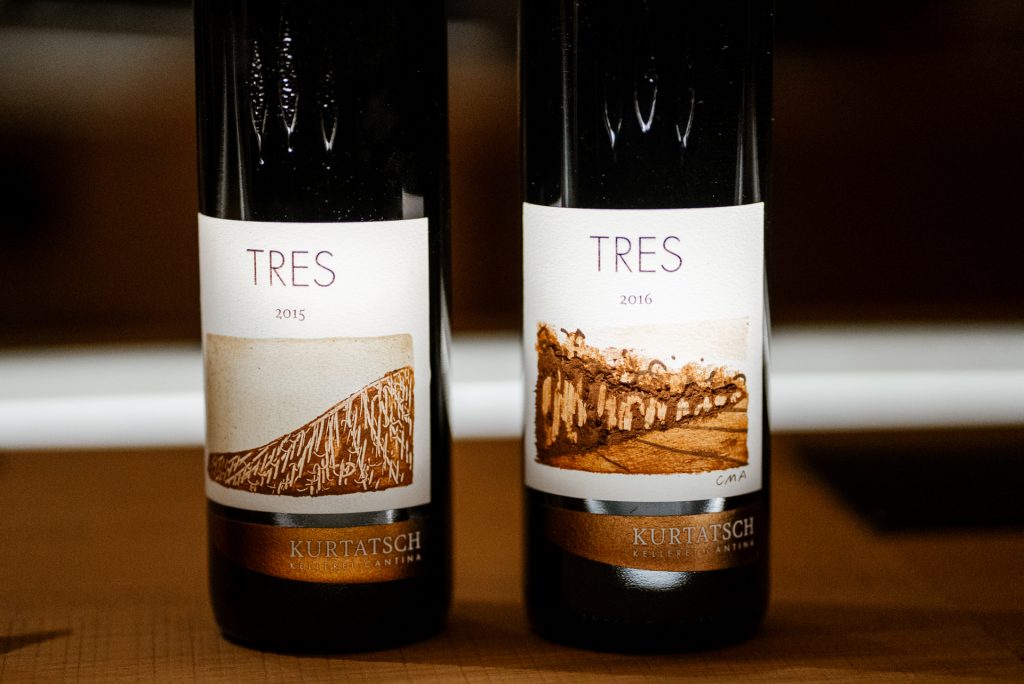
2016 is the second vintage produced and the presentation was in line with what should be expected of a product of such standards. An evening that consisted of culinary delights prepared by Michelin stared chefs, a tour of the winery and tasting of the producer’s four other red wines from these varieties from the 2016 vintage, and a presentation of the young local artist, Carmen Maria Alber, who hand painted every single label of the Tres of the almost three thousand bottles – finishing the last ones on the night itself.
The main event of the evening, however, was the blind tasting of this latest vintage – made of 70 % Merlot, 25 % Cabernet Franc and 5 % Cabernet Sauvignon – against four wines of great reputation of the same vintage and made from the same varieties, yet of slightly different composition: Chateau La Mission Haut Brion, Redigaffi by Tua Rita, Chateau Pavie 1er Grand Cru Classé A, and Masseto by Ornellaia. Big names, big wines. The question you will ask now, I reckon, probably is how the Tres fared amongst such fierce competition. Theoretically, the tasting sheet also provided for the assignment of points of each wine, yet, we did not proceed with this exercise and instead had an open discussion where some of the participants shared their views about the wines. Again, I would not consider it necessary to fall back to the use of ratings as – similar to Cortaccia Rossa – the objective was to present the local wine in comparison with its peers. This test the Tres passed with flying colours. Was it better, equal or worse than the others? I would say that that would be a rather pointless affirmation to make, as it would be subjective and depending on the preference for the respective styles, especially since we were clearly tasting five fantastic wines.

Across the finishing line
Three events, three stages that provide a glimpse on what the wines of Südtirol represent today. An occasion to test the pulse, to gain valuable insights and to draw some conclusions what the future might hold for this small place in the big world of wine. Südtirol has once more underlined its commitment to producing high quality and that beginning at their entry level wines all the way up to those wines that can hold their ground against the world’s finest.
Such an achievement is the result of hard work, a lot of discipline and the understanding that in a competitive environment such as the global wine industry nothing less will suffice. Having the right base ingredients helps, but is only the foundation of the region’s success.
Nonetheless, Südtirol, like the rest of the world will be (and already is as discussed above) confronted by several challenges on the road ahead. Global warming, a deteriorating economic environment, and ongoing societal changes. Panta rhei. Everything flows.
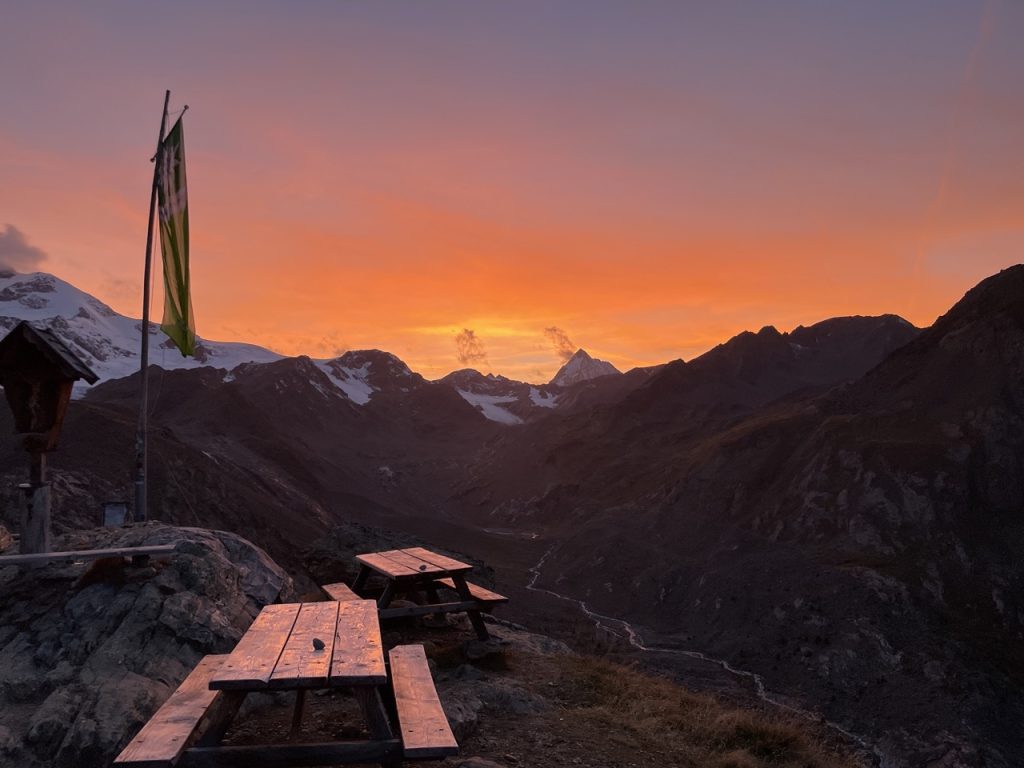
—
Disclaimer: As always, I’d like to be completely transparent about affiliations, conflicts of interest, my expressed views and liability: Like anywhere else on this website, the views and opinions expressed are solely those of the original authors and other contributors. The material information contained on this website is for general information purposes only. I endeavour to keep this information correct and up-to-date, I do not accept any liability for any falls in accurate or incomplete information or damages arising from technical issues as well as damages arising from clicking on or relying on third-party links. I am not responsible for outside links and information is contained in this article nor does it contain any referrals or affiliations with any of the producers or companies mentioned. As I said, the opinions my own, no liability, just thought it would be important to make this clear. Thanks!
